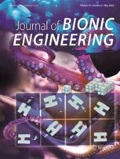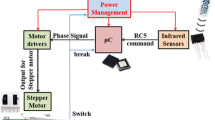Abstract
This paper presents a multi-agent robotic fish system used for mariculture monitoring. Autonomous robotic fish is designed to swim underwater to collect marine information such as water temperature and pollution level. Each robotic fish has 5 degrees of freedom for controlling its depth and speed by mimicking a sea carp. Its bionic body design enables it to have high swimming efficiency and less disturbance to the surrounding sea lives. Several onboard sensors are equipped for autonomous 3D navigation tasks such as path planning, obstacle avoidance and depth maintenance. A robotic buoy floating on the water surface is deployed as a control hub to communicate with individual robots, which in turn form a multi-agent system to monitor and cover a large scale sea coast cooperatively. Both laboratory experiments and field testing have been conducted to verify the feasibility and performance of the proposed multi-agent system.
Similar content being viewed by others

References
Hormann A. A petri net based control architecture for a multi-robot system. Proceedings of IEEE International Symposium on Intelligent Control, Albany, N Y, US, 1989, 493–498.
Agah A, Doyle B, Drees M, Froehlich C, Kuok K. Robot soccer for the study of learning and coordination issues in multi-agent systems. Proceedings of IEEE International Conference on Systems, Man, and Cybernetics, San Diego, US, 1998, 4, 3520–3525.
Hiraishi K. A petri-net-based model for the mathematical analysis of multiagent systems. IEICE Transactions on Fundamentals of Electronics, Communications and Computer Sciences, 2001, 84, 2829–2837.
Hirata K, Takimoto T, Tamura K. Study on turning performance of a fish robot. First International Symposium on Aqua Bio-Mechanisms, Mitaka, Tokyo, Japan, 2000, 287–292.
Cho K, Park H, Kim S, Yang H, Park Y. Development of robot mimicking propulsion of a fish. Korean Society of Mechanical Engineers, 2007, 40–45.
Oyekan J, Gu D, Hu H. Visual imaging of invisible hazardous substances using bacterial inspiration. IEEE Transactions on Systems, Man and Cybernetics: Systems, 2013, 43, 1105–1115.
Ryuh Y. Development of swimming mechanism and algorithm of fish-like underwater robot. Korea Robotics Society, 2009, 43–48.
Oyekan J, Hu H. A novel bio-controller for localising a pollution source in medium peclet environments. Journal of Bionic Engineering, 2010, 7, 345–353.
Oyeken J, Lu B, Hu H. A creative computing approach to 3D robotic simulator for water pollution monitoring. International Journal of Creative Computing, 2013, 1, 92–119.
Wang S, Chen L, Hu H, Xue Z, Pan W. Underwater localisation and environmental mapping using wireless robots. Journal of Wireless Personal Communications, 2013, 70, 1147–1170.
Streitlien K, Triantafyllou G, Triantafyllou M. Efficient foil propulsion through vortex control. AIAA Journal, 1996, 34, 2315–2319.
Kim Y. Robotic fish, the prince of ocean. Dong-A Science, 2005, 8, 54–59.
Jalbert J, Kashin S, Ayers J. A biologically-based undulatory lamprey-like auv. Proceedings of the Autonomous Vehicles in Mine Countermeasures Symposium. Montery, US, 1995, 39–52.
Guo S, Fukuda T, Kato N, Oguro K. Development of underwater micro-robot using ICPF actuator. Proceedings of IEEE International Conference on Robotics and Automation, Leuven, Belgium, 1998, 2, 1829–1834.
Yu J, Tan M, Wang S, Chen E. Development of a biomimetic robotic fish and its control algorithm. IEEE Transactions on Systems, Man, and Cybernetics, Part B: Cybernetics, 2004, 34, 1798–1810.
Liu J, Hu H. Biological inspiration: From carangiform fish to multi-joint robotic fish. Journal of Bionic Engineering, 2010, 7, 35–48.
Kato N. Control performance in the horizontal plane of a fish robot with mechanical pectoral fins. IEEE Journal of Oceanic Engineering, 2000, 25, 121–129.
Chen Z, Shatara S, Tan X. Modeling of biomimetic robotic fish propelled by an ionic polymer-metal composite caudal fin. IEEE/ASME Transactions on Mechatronics, 2010, 15, 448–459.
Klein D, Gupta V, Morgansen K. Coordinated control of robotic fish using an underwater wireless network. Mazumder S K (Ed.), Wireless Networking Based Control, Springer, New York, US, 2011, 323–339.
Polverino G, Abaid N, Kopman V, Macr S, Porfiri M. Zebrafish response to robotic fish: Preference experiments on isolated individuals and small shoals. Bioinspiration & Biomimetics, 2012, 7, 036019.
Liao B, Li Z, Du R. Robot tadpole with a novel biomimetic wire-driven propulsor. IEEE International Conference on Robotics and Biomimetics (ROBIO), Guangzhou, China, 2012, 557–562.
Reisig W. Petri nets and algebraic specifications. Theoretical Computer Science, 1991, 80, 1–34.
Ryuh Y, Moon J. Multi-agent control and implementation of bio-inspired underwater robots for mariculture monitoring and control. IEEE International Conference on Robotics and Biomimetics (ROBIO), Guangzhou, China, 2012, 777–783.
Author information
Authors and Affiliations
Corresponding authors
Rights and permissions
About this article
Cite this article
Ryuh, YS., Yang, GH., Liu, J. et al. A School of Robotic Fish for Mariculture Monitoring in the Sea Coast. J Bionic Eng 12, 37–46 (2015). https://doi.org/10.1016/S1672-6529(14)60098-6
Published:
Issue Date:
DOI: https://doi.org/10.1016/S1672-6529(14)60098-6



